Before the worldwide web and internet radio dominated our way of catching the news and sending us music and entertainment, America had its own locally owned “inter-web.” It was called AM Radio and, of course, it still exists in many cities and communities across the country. There’s an AM station in Cortez, Colorado, 60 miles east of San Juan County, Utah. Grand Junction boasts a few. Price, Utah has an AM station. According to Wikipedia, AM radio broadcasting uses “amplitude modulation” (AM) transmissions, whatever that means, to send a radio signal through the air; it was the first form of radio broadcasting. Its origins go back to the early 1900s, but it took another 20 years for it to become the incredibly popular and dominating form of entertainment and news genre. For three decades AM Radio’s “ Golden Age” was heard in America by nearly the entire population of the country. Small AM stations appeared overnight in some of the most remote corners of Rural America. For those who lived far from the cities, these tiny, low powered radio stations were a vital link to the outside world.
When I started traveling around the country in the late 60s, I would pass from the broadcast perimeter of one small AM station and into the sphere of the next. At the time, one of the most isolated parts of the country was the northwest corner of Wyoming. Just south of Yellowstone and Grand Teton National Parks, the little village of Jackson nestled tightly between the base of Gros Ventres Buttes and Snow King Mountain. Remarkably, even here, the town had its own AM station. KSGT-AM signed on daily at 7 AM and went dark at ten in the evening. Every night the little station ended its broadcast day with a very conservative commentary called, “Liberty Lobby,” that was funded by the Hunt family. Then Perry Como sang the Lord’s Prayer.
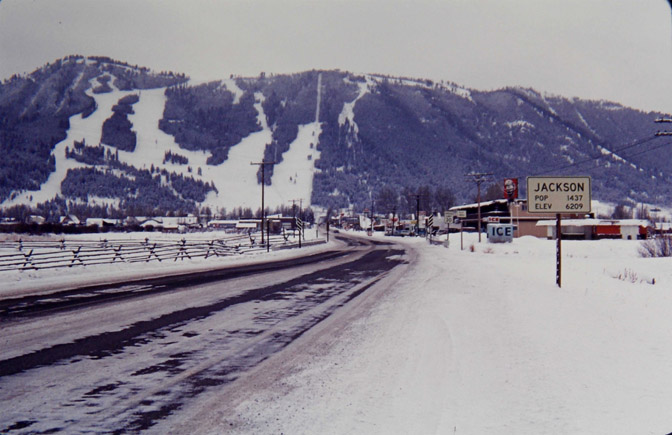
I still have an old cassette recording somewhere of KSGT’s heavenly sign off with “Mr C.” Finally, the station manager said goodnight, noting that “KSGT was owned and operated by the JGJ Corporation and broadcast at a power of 250 watts during the day, and 50 watts at night.” I think I usually lost the signal about halfway to Moose Junction. (KSGT is still on the air as a Spanish-speaking AM station).
But the AM station I relied most heavily on, and the station I still miss, was KUTA in Blanding, Utah, “790 on your AM dial.,” aka “The Mighty 790.” It sat atop “Radio Hill,” about five miles north of town and just off the old highway. When the Recapture Dam was completed and US 191 was re-routed to go over the top of it, the traffic outside KUTA ground to a halt, but the little station kept broadcasting from its cinder block headquarters. It was probably one of the most scenic locations for a radio station that ever existed. And until the Millennium it was probably the only station that a traveler or a resident could pick up during the day. Once the sun set, the more powerful “clear channel” stations, those boasting 50,000 watts of power, would start to override the small AMs and completely dominate the airways. We all knew them by heart and where to turn on the dial.
From my quiet little shack in San Juan County, I could pick up KNX-1070, the West’s only all news radio giant out of Los Angeles. KSL-1160 was Salt Lake City’s pride and joy. Albuquerque was home to KOB-770 and Denver claimed KOA-850. If you wanted rock and roll oldies, there was only one station to consider— KOMA-1520 in Oklahoma City. That signal made its way to the Rocky Mountains and Monticello, Utah. Sometimes I could even tune in to some of the big eastern Am stations like WLS-890 in Chicago or my old hometown radio, WHAS-850, “the 50,000 watt ‘cuddly giant,’” it bewilderingly called itself, in Louisville, Kentucky.
But until the sun went down, it was pretty quiet out there. If you were in need of the sound of a human voice, there were few options. I have discovered for myself that I love solitude and peace and being away from noise and human chaos, as long as it’s optional. If I know I can return to friendly faces and people who care about me, if I know that my solitude is limited to the amount of time that I enjoy it, then it’s perfect. But when total aloneness is the only choice left to me, that’s when, for me, being alone feels more like ‘lonely.’
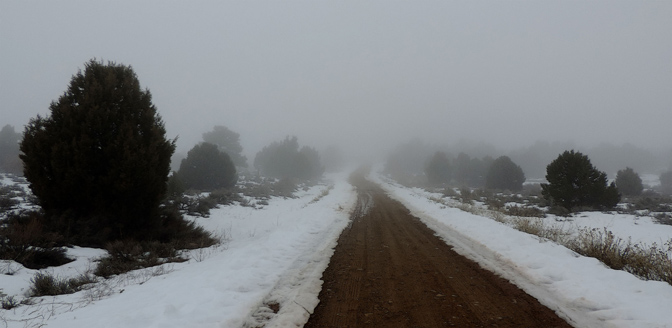
Back in the early 80s, I was trying to live by myself through a brutal winter in SE Utah, in deep snow and zero temperatures at night, with only a Montgomery Ward wood stove for warmth, and with full knowledge that my 1963 Volvo probably wouldn’t start the next morning. I had a little cassette player to listen to music, but there were no cell phones then, and sometimes I just longed for a live human voice. It’s why on some days, I almost said a prayer of thanks to the little station seven miles south of me. God bless KUTA. I was so close that the signal always came through loud and clear. Thinking back to the early 80s, even before Phil Mueller took over its management, I can remember a lot of local programming, rural talk shows, farm reports, There were a lot of radio commercials on the air that targeted Navajos living in San Juan County and they were broadcast in their language. So I would hear this strange voice on the air that I could not begin to understand, but then in the middle of it, I’d hear, “Quality Ford Blanding” or “Parley Redd Mercantile,” and I knew then, at least, what the subject matter was.
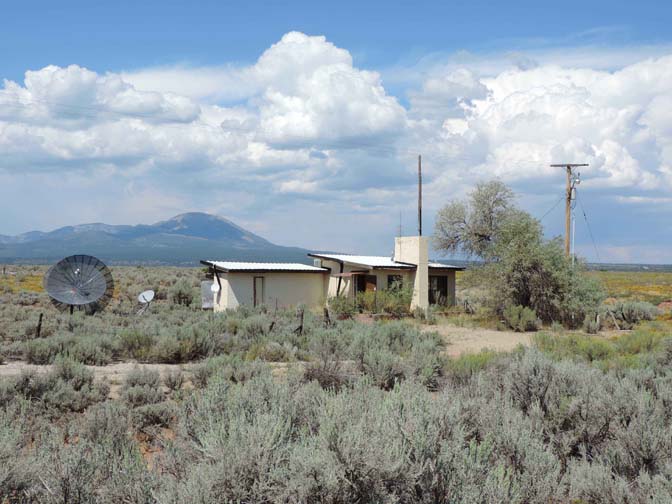
KUTA covered all the local football and basketball games and often the station manager did the play-by-play. After 1987, it was Phil. (Who owned the station before him, I couldn’t say but would love to find out.) One odd aspect of the station in the early 80s was its nightly sign-off music. They didn’t play the “Star Spangled Banner” or “America the Beautiful.” For some reason the KUTA broadcast day ended with an original saxophone composition by James Last. Years later I learned it was the “Love theme” for the movie “American Gigolo.” Go figure. But the music was haunting and seemed to fit the bleak cold gray afternoons of so many winter days on that ridge that looked out to the south and the Chuska Mountains. To this day, I shiver when I hear that music. And feel a tad lonesome.
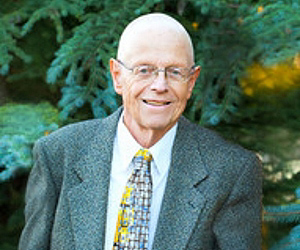
When Phil Mueller took over the station, he was dedicated to getting the news out to his listeners and if I recall correctly, he broadcast many city and county meetings. He also collected and presented a local news summary every evening. And of course where I could also tune in to hear “Paul Harvey and The News” and later, “The Rest of theStory.” To this day, he’s still my favorite radio news voice. But in the late 90s, as the internet grew and FM stations became more prevalent, KUTA, like so many other AM stations, began to lose revenue. Finally on March 14, 2002, Phil Mueller made this announcement:
“This is Phil Mueller, speaking to you from high atop Radio Hill, with a final commentary from KUTA-AM 790…Yes, I did say final. This is a very difficult commentary, because there is nothing I would rather do than continue broadcasting to you forever as ‘The Voice of The Canyonlands,’ but it is no longer economically feasible to continue operations.”
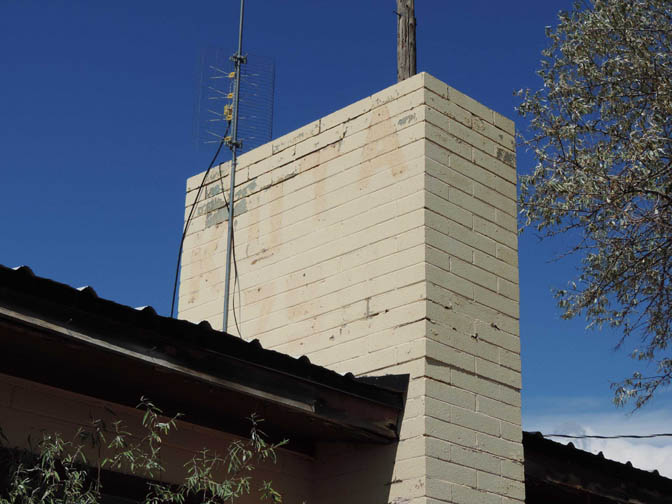
It was the end of KUTA after 41 years on the air. Phil Mueller later took a new job with KCYN-FM in Moab and became its manager until his tragic death from cancer in 2016. Thanks to Phil, KCYN was the ONLY media source in Moab that reported any of the information from my long February 2016 investigative report about the Moab City Council’s questionable activities. It was my story that got The Zephyr sued by the former city manager. The other media reported the lawsuits, but only Phil would report on the content of my story. I will always admire and respect him for that.
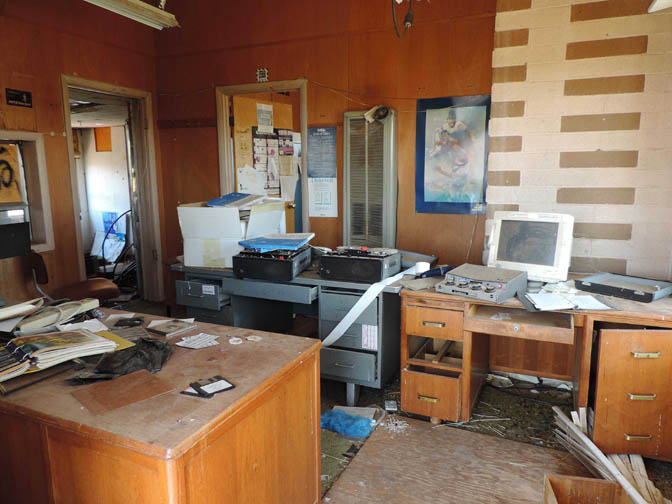
****
A few years ago, I was returning to Monticello from Blanding and decided to make a detour where the old highway intersects with US 191. A couple miles north, I saw the old radio station, still there, but looking forlorn and forgotten and in a steady state of decay. The call letters had been pulled off the facade of the building, but their ‘shadow’ remained. To my surprise the doors were open and most of the original equipment was still inside. I guess it had already become outdated and was of no further use to anyone. Tipped over file cabinets, furniture, even old tape machines still littered the rooms. I thought of all the history that was reported out of this little cinder block building. Good news and bad. Winning games and losses. Young men and women probably got their first lessons in broadcasting from this remote location. And now for many, they don’t even know that KUTA ever existed.
But I remember, and whether they knew it or not, that little AM station helped me through some very lonely days—thanks to those comforting voices and tones, “from high atop Radio Hill.”
JIM STILES is editor/publisher of The Zephyr since 1989.
(For a story about SE Utah’s other AM radio station, Moab’s long departed KURA, click here. )
TO COMMENT, scroll to the bottom of this page
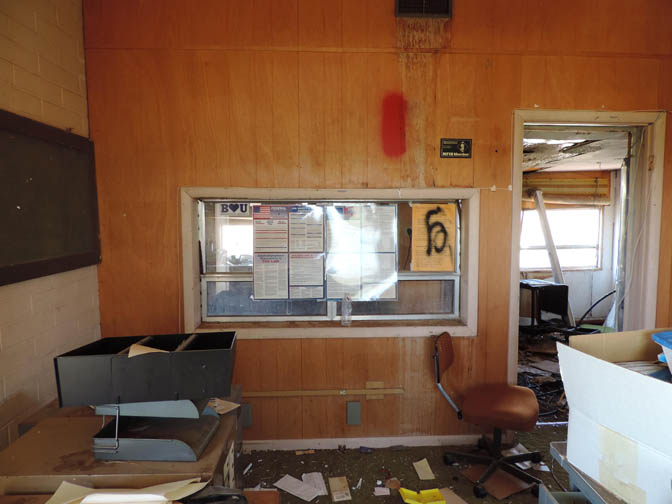
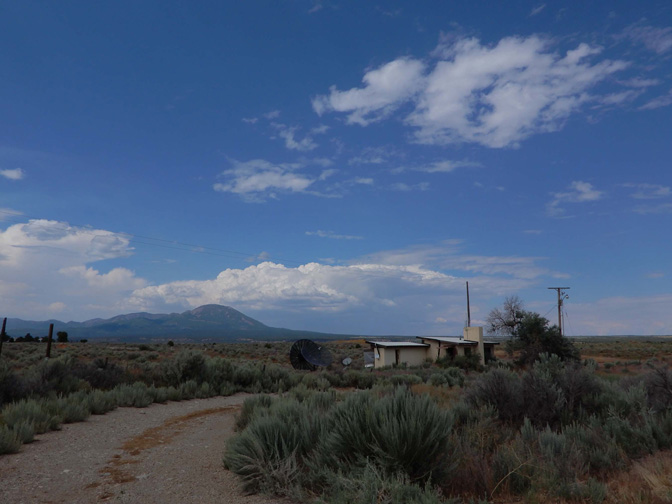
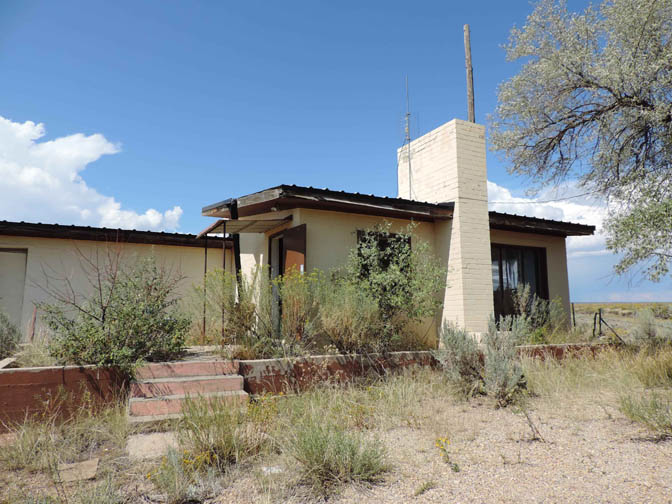

.


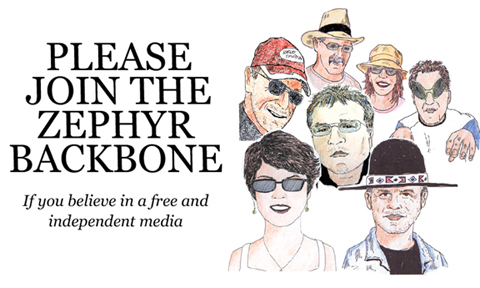

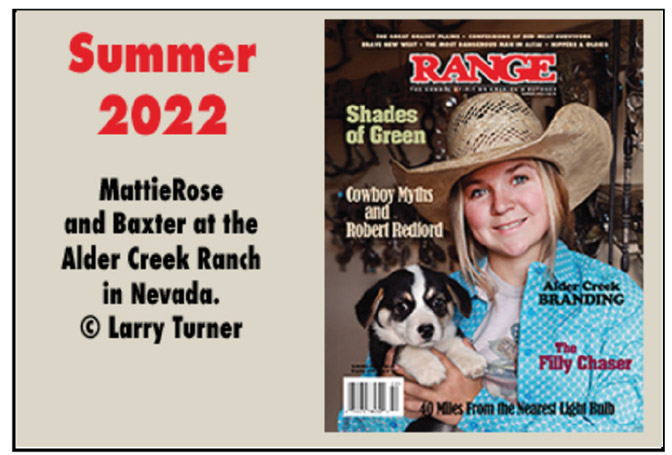

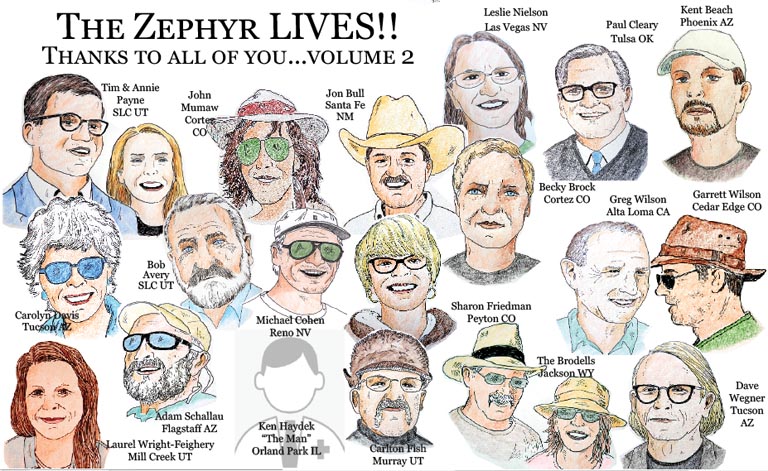
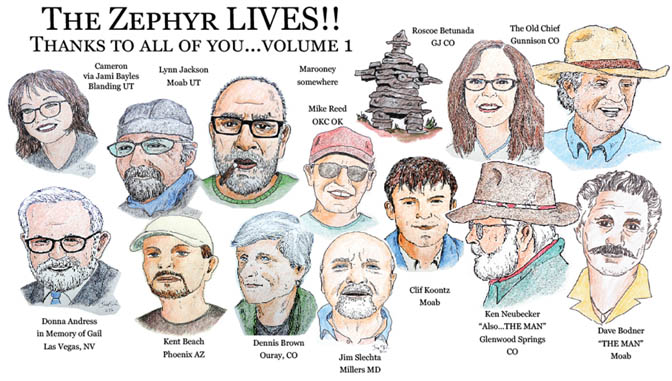
Hello Jim
When Tuck and I were in remote parts of the Colorado Plateau, he always tuned in at night, sometimes to big stations, and often found Navajo stations. How amazing it was, to be out in the ‘middle of nowhere’ at night and bring in these voices from afar.
Good memories
During my two seasons at Natural Bridges NM (1970-1971), my bride and I listened, sometimes reluctantly, during the day to the only radio station we could get, KUTA of course. They played country music (we called it CW) at the time, not really our favorite, but we appreciated the voice out there that told us we were “home” in the canyonlands. And, yes, the Paul Harvey broadcasts were a regular “must listen”.
So on a return trip on vacation in the mid-1970s, we turned to AM 1450 as we headed into San Juan County. Something was amiss. The radio emitted a song by Elton John, “Don’t Go Breaking My Heart”. More rock songs followed (our forte at the time) while we traveled wondering if we had mis-dialed. But the station identification revealed that, yes, we were listening to the radio anchor of the canyonlands, KUTA!
Thanks, Jim, for this blast from the past. Oh, and yes, at night way back then, we listened pretty faithfully to KOMA. One of the hits of the time was “In the Summertime” by Mungo Jerry. Ah, memories!
Great piece, Jim. I remember listening to KOMA in OKC at night growing up in Kansas. My other favorite was, ” your listening to XERF in Ciudad Acuña Coahuila Mexico”, bible thumping evangelists in the daytime but at at night Wolfman Jack, before he became famous broadcasting from south of the border near San Diego, played the funkiest of blues sponsored by a record store in New Orleans that sold “race music”. XERF was a border blaster with 250,000 watts and could be heard all the way up the plains and into the south. while my friends were listening to Frankie Avalon and the ’50s Philly sound i was listening to the lowdown blues late at night.
During road trips today in the mostly FM radio free wide open spaces of the southwest and southern plains, I always flip the dial to AM and listen to the local stations.
K O M A ?! in the mid-to-later 60’s in the mtns outside of Denver, this was the strongest night-time station — wotta range — and, yes, that 1M watt (so i was told) from Mexico also dominated at night ~
When we were first trying to get a college going in San Juan county in the late 70s and early 80s Jim Kindred and I and others would use KUTA and Phil to spread the news far and wide. We were not big shots but having KUTA to broadcast our message was a big help.
Your article and photos are an excellent source for historians to follow up on.
A Phil Mueller story that I think is true and so characteristic of Phil is about his desire to work in rural radio. Even while he was taking cancer treatments he would leave Blanding in the middle of the night and drive to Moab to work at the radio station. He said that the local state highway patrol did not stop him for driving very fast in the middle of the night because they were sure it was Phil on his way to work.
Love the story–brings back memories of top-40 radio back east. I was fond of falling asleep with a transistor radio beside or under my pillow and my folks would have to come later and turn it off. In later years, I got a fancier radio and was excited to tune in a hockey game from St. Louis. I would take that little transistor radio to Sunday School and run a hidden wire with an earpod while Mr. Sadoff (you can imagine what we called him) droned on about some old testament stuff, or more usually, the holocaust. I was more interested in Casey Kasum’s national program. The stations were WEAM out of Arlington VA and WEEL out of Fairfax. Thanks for spurring the memories.
KUTA actually broadcast on 790 kHz, not 1450. Without getting into the physics, its signal carried much farther than KURA even though both stations only broadcast with 1 kw.
Before Phil Mueller owned the station it was owned by Shelby Smith – Smith Media Corporation. He owned the station from the early – late 80’s. I believe he currently resides in Santa Fe.
Before Smith owned the station it was owned by Eddie Boyle, George Walton & Earl Stephens from the early 70’s on.
As a Monticello native KUTA was a big part of my life on a daily basis.
As a matter of fact my wife worked for Smith for several years selling advertising & doing an on air shift. It was during her sales calls at my place of employment that we began to fall in love & eventually marry.
Even though I haven’t lived in Monticello for 30 years it is fun to reminisce about KUTA. Back in 2010 my wife & I were traveling from Monticello to Blanding & took the same detour you described to view the remains of the station. My memories of that day match the pictures you posted.
K O M A ?! in the mid-to-later 60’s in the mtns outside of Denver, this was the strongest night-time station — wotta range — and, yes, that 1M watt (so i was told) from Mexico also dominated at night ~
KOMA Oklahoma City.
Thank you so much; very evocative piece. I recall stations in my college years that helped me keep my sanity through all the tumult of marching for the Equal Rights Amendment, etc.
(by the way, we now support ‘Community Solar powered Radio’ locally in GJ)
Great story. KUTA 790 was a staple of my youth growing up. When I was eight or nine, I told my dad that I wanted to be a voice on KUTA so he dutifully packed me up and drove me to Radio Hill. They recorded me reading a script and very kindly told me that even though I had “great talent”, I was not quite ready yet. There were many people who were involved in the radio station over the years, including the Holmes, Blickenstaffs, Smiths and more. A few years after my audition, my father became a part owner of KUTA with George Walton and Earl Stevens. Local radio returned to San Juan County when I purchased Redrock Radio in 2020. Even though we made a jump to FM (and live streaming), the weekday broadcasts of The Redrock Radio Morning Show is our attempt to follow in the footsteps of the radio pioneers KUTA, from the very beginning to Phil Mueller. They are large shoes to fill!
Hi Jim,
In answer to your question, the first owners of KUTA were Dale and Willa Don Holmes. They lived in Blanding, and ran the station for years. I know, because my Dad and four of my brothers actually were the “Voice of the Canyonlands.”
My brother, Scott Blickenstaff, was the first of the family to work for Dale, circa 1964, followed by my dad, Gene Blickenstaff, brothers John, Kurt, and Todd being the last under the ownership of a guy named Shelby Smith, circa 1981.
My brothers and Dad actually selected music (from real vinyl records!), read news, did live ads, etc. The station hosted the “Navajo Gospel Hour,” Willadon’s “Birthday Club of the Air,” and for a time, a live in-station talent show. The station procurred a piano for that very purpose. As little sister, I performed Leucona’s “Malaguena” live on the air, probably around 1969. I remember it well because after a stirring performance, I missed the very last note! I hoped no one heard the mistake, but my piano teacher, Mabel June Palmer was listening!
KUTA was an important part of life around the Blickenstaff household for many years. Thanks for your article!
Thanks so much for the information. I almost feel like I should re-write the story…Next time I am out there, I’d love to talk to you all. Thanks again…Jim
Cool story, cool history lesson….Thanks!
Actually, Jack Hawkins was the orignal owner. Jack operated KVFC in Cortez, Colorado and built the station. I worked at KUTA, just out of high school. In fact, I was on the air when the news broke of President Kennedy’s assassination in 1963. I was aquainted with the Blickenstaff family and was friends with Scott. Dora Shumway was the secretaryfor KUTA at the time. KUTA’s demise is sad.
Thanks for a wonderful article about my former place of employment.
As my sister, Denise, referred to in the previous comment, when I was about 15 years old, I got a job as a disc jockey at KUTA . It had a 1000-watt transmitter full of glass tubes that had to be warmed up for 15 minutes before we went on the air each morning. We broadcast from sunrise to sunset.
I started out working weekends, playing pre-recorded programs, and hosting a country and western music program in the afternoon. I came to love country music, which I didn’t know anything about at the time. Eventually, I read the news, gave weather forecasts, read commercials, and provided color commentary at Little League baseball games we covered live.
I passed the Federal Communications Commission’s entry level exam and was certified with a Third Class Radiotelephone Operator License, which was required for announcers who operated low-power radio broadcast stations.
I had to work on some Sundays, but Dale always scheduled my hours to allow me to go to church before work. One Sunday I was looking out the window to see who would be in the first car driving home from stake conference, which was held in Monticello. I recognized one of my high school teachers, who was speeding past. I got on the air and welcomed everyone home to Blanding from stake conference. I said if there happens to be a law enforcement officer listening, I just saw Dick Guymon speed past in his blue station wagon. The next day at school, as I walked down the hall past Mr. Guymon, he said, “Very funny, Mr. Blickenstaff.”
I agreed.
One summer, the owner, Dale Holmes, spouse of WillaDon – hostess of the Birthday Club, was taking a short vacation at Lake Powell. He asked me to open the station up in his absence. My Mom woke me up and said Dale was on the phone. He asked me if I was ok and then asked me if I knew what time it was. I had slept through my alarm! He waited 15 minutes past broadcast time and then figured I was home in bed. I quickly dressed, raced up Broadcast Hill, and got us on the air about 40 minutes late.
I worked at the station during the school year and took on additional jobs in the summer. I was at KUTA from the fall of 1968 to the spring of 1971.
Thanks John…like I noted to your sister, that really fills in some blanks for me. If you all are still in the Blanding area, it would be great to hook up with you and hear more stories…Take care and my thanks for those great radio memories…Jim
(also it was pointed out to me that I have the call number wrong…I somehow flipped KUTA and KURA’s frequency in my head…KURA was 790 and KURA was 1450 (I think)
Jim, nice story – and sad. I hope someone rescued that nice looking wood furniture out of the old station. I treasure my quarter-sawn oak plywood desk from the USFS that was headed for the dump. s
We used to listen to KUTA back in the late 50’s and early 60’s. There was a station closer to Cortez CO with the letters KVFC. I suppose it went that way of KUTA. But you are right KOMA ruled the nite time with its Rock and Roll. Now I believe it (KOMA) has become a “TALK show”. but I never listen except when on the road.
Good to see you are doing well Jim.
Like you, Jim, I still have cassette tapes of a favorite radio station, WCHD, Stereo, Detroit, The Jazzy One. I recorded them in the late Sixties before moving to Colorado. I sometimes play them while I’m working in my garage very close to the sidewalk. I always hope that someone will walk by and hear the call letters and stop, hasn’t happened yet, darn.
I worked selling ads for stores in Blanding, Monticello I even sold one to Dick Dave’s Used cars in Cortez Colorado, of course it helped that Dick was my brother in law 😅. My son Mike ( Herring) Carlson also worked there in his junior year. I worked for Phil…I am not sure who had when Mike worked there.
Driving across Nevada from Reno to Salt Lake at night was an other-worldly experience. If there was a full moon, the desert would glow with the illumination of the sandy earth. New moon nights brought the bowl of sky filled with stars edged abruptly along the horizons by the stark black silhouette of the mountains’ jagged ridges. There would be a variety of high-powered stations, during the 70s playing little more than Anne Murray, Gordon Lightfoot, and the BeeGees. Then, a loud station would break through, sending its reverberating signal from some place called Fallon. The ads, one for a furniture store, made it sound like a major city somewhere to the south of I-80 between Battle Mountain and Fernley. Despite the growth in Nevada towns, many of them are still hanging by their toenails level surviving. Back in the 70s, Elko and Winnemucca promised to be a big deal some day…maybe. Fallon? Where the hell was that? And was it really a town or was it a cinderblock building with a Wolfman Jack DJ sucking popcicles and playing tunes out there in the desert. God bless the guy, whoever he was, because he made that long drive so much more endurable.
Phil Mueller broadcast the news in Denver during the morning hours on station KIMN, 950 AM. That’s where I met him in April 1971. He left the station within a week or two when a new owner slimmed down the news department and let Phil go, along with several others.
I never knew where Phil went, until one day, while vacationing in southern Utah, around 1986, 1987 or 1988, I was listening to KUTA 790 AM and heard Phil broadcasting the news. I found my way to Blanding, Utah, and found the station building. I went inside and reintroduced myself to Phil. He probably explained how he went from Denver to Blanding, but I don’t remember.
AM radio has appealed to me since I was 13 years old and I started listening with a transistor radio. I like it how AM signals go various distances, depending on station power, dial position and time of day. For a given power, stations lower on the dial go farther than stations higher on the dial. This can differ in certain directions for AM stations with directional signals.
KUTA’s dial position, 790, was fairly low, which meant that with 1,000 watts and a nondirectional antenna, the signal went much farther that signals from stations in the 1400s and 1500s on the dial with the same power.
Jim Stiles, I much enjoyed the story you wrote, and I also enjoyed the comments posted by others with details to offer about KUTA’s history. I could not recall what the station building looked like, but the photographs brought back the memory. Sure enough, that’s the KUTA where I visited Phil some 35 years ago.
About other stations mentioned: KOMA 1520 AM broadcasted with a 50,000-watt nondirectional signal during the day and a directional signal at night that mostly went north, although it wasn’t a narrow north-going signal. KOMA could be heard in the western half of the United States at night. Another station on 1520 AM, WKBW in Buffalo, New York, covered the eastern half at night with 50,000 watts and a signal that mostly directed to the south.
KOMA changed its call letters to KOKC, and in 2015, a tornado destroyed two of its three towers. Since then, it has been broadcasting with 10,000 watts day and night on a single tower, making its signal nondirectional. This year (2022), the station received an okay from the federal government for its plan to rebuild its 50,000-watt signal.
The old KURA in Moab, Utah, on 1450 AM, broadcasted with a 1,000-watt nondirectional signal. I never heard it when it was KURA, but I recall hearing it with the call letters KMOB when I visited Moab.
The old KUTA frequency, 790 AM, is widely used throughout the United States by stations with regional coverage areas. The frequency might never be put to use in Utah, again, given the preference most people have to listen to FM compared with AM. Funny thing, though. I just read that, by a fraction of a percentage, more people now listen to radio stations, whether AM or FM, on their smart phones, than they do by listening on radios. This year is the first time that difference has been measured in favor of smart phones.
XERF, another station mentioned here, operates on 1570 AM, and it once used a 250,000-watt transmitter. The 250,000-wat transmitter failed, long ago, and the chances of it resuming 250,000 watts of power are slim. Reasons include the difficulty in finding or fabricating parts, the difficulty in finding engineering talent with the knowledge to rebuild such a transmitter, and the lack of an economic reason to do so. You can’t imagine the electric bill for operating a 250,000-watt transmitter. Moreover, the Mexican government wants to move as many AM stations as possible to FM, provided the change doesn’t leave any listeners without broadcast service. Thus, XERF now operates at 50,000 watts to 100,000 watts, according to available sources, and it is more likely to cease operations at some future time than it is to increase its power.
In 1983, a talented engineer named Mike Vendetti restored the transmitter to 250,000 watts when, seemingly, no one else could, so the story goes. You can watch a video of Wolfman Jack performing on XERF in a guest appearance to celebrate the return to 250,000 watts. On YouTube, put “XERF Wolfman Jack” into the search window. Coincidentally, I met Mike in 1976 when we both worked at a 500-watt AM station. What a difference, huh. 500 watts to 250,000 watts.
I spent much of my youth at KUTA. Not as an employee, but spending time with my brother while he worked. When I was 16, I was hired to paint the building. It was previously a blueish green, as you can see in those photos. I painted it pale yellow with dark brown trim, which seems to have held up pretty well for over 45 years. I painted the KUTA 790 lettering brown, as well. Years later, those brown letters somehow ended up in the front yard of Todd Blickenstaff in northern Utah. I also hauled water up to fill the tank since there was no well or public water at the station. I went with my brother, Earl, on countless road trips where he broadcast live or recorded for replay, San Juan Broncos games and matches.
Actually, Jack Hawkins was the orignal owner. Jack operated KVFC in Cortez, Colorado and built the station. I worked at KUTA, just out of high school. In fact, I was on the air when the news broke of President Kennedy’s assassination in 1963. I was aquainted with the Blickenstaff family and was friends with Scott. Dora Shumway was the secretaryfor KUTA at the time. KUTA’s demise is sad.